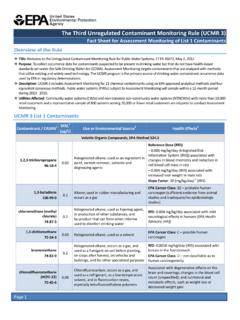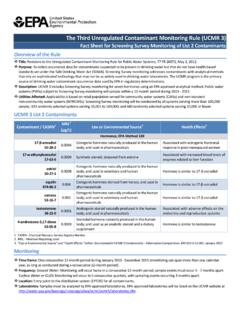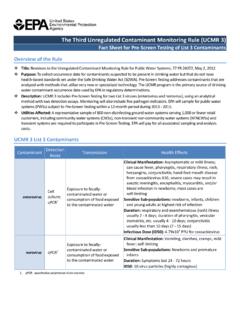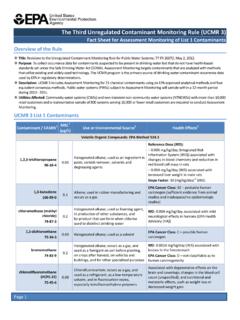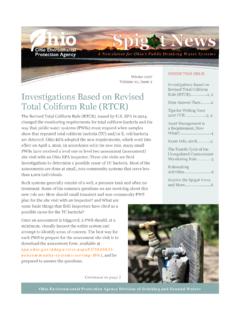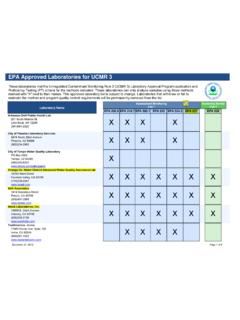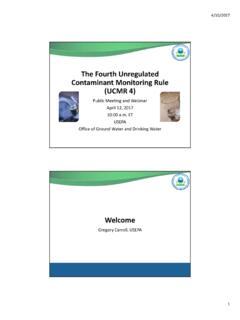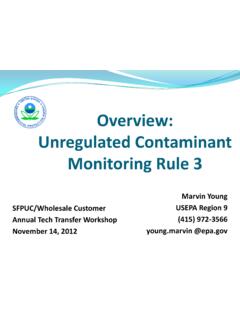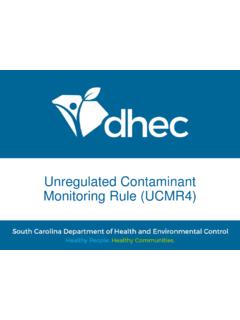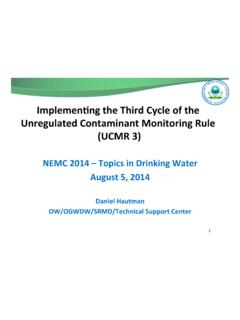Transcription of CCL, UCMR, Monitoring Results, and Development of ...
1 CCL, UCMR, Monitoring results , and Development of RegulationsAWWA PA Section / WWOAP ConferenceExton, PAApril 7, 2016 Charles D. Hertz, Water RegulationsDevelopment of regulations Plans set forth in SDWA Systematic approach Other avenues Definition of terms UCMR data national localRegulatory Development ProcessDrinking Water regulations Prior to 1996 SDWA amendments 25 new MCLs every 3 years After 1996 SDWA amendments Outlined process for contaminant Candidate List (CCL) unregulated contaminant Monitoring Rule (UCMR) Regulatory Determination Health Advisoriessystematic, science-driven process2001 publicationNational Academies PressContaminant Candidate List Used by EPA to identify priority contaminants for regulatory decision making and information collection Known or anticipated to occur in drinking water Must be published every 5 years Wish listSDWA defines " contaminant " as any physical, chemical, biological or radiological substance or matter in waterUnregulated contaminant Monitoring Rule Allows EPA to collect data on parameters suspected to be present in drinking water Occurrence data Up to 30 parameters Suitable analytical method List 1: assessment Monitoring List 2: screening survey List 3.
2 Pre-screen testingRegulatory DeterminationThree Criteria Required in contaminant may have an adverse effect on the health of contaminant is known to occur or there is substantial likelihood the contaminant will occur in public water systems with a frequency and at levels of public health the sole judgment of the Administrator, regulation of the contaminant presents a meaningful opportunity for health risk reductions for persons served by public water systems EPA is notlimited to making regulatory determinations from CCLSix Year Review: primary standardsDrinking Water regulations First 6-year review: 2003 Candidate for revision: Total Coliform Rule No revision: 68 chemical MCLs Second 6-year review: candidates for revision, 2010 acrylamide epichlorohydrin Tetrachloroethylene (PCE) Trichloroethylene (TCE)systematic, science-driven processCriticism of regulatory Development process Too science-driven Few new standards Few candidates for review Low rate of occurrence UCMR rounds have had questionable impact Not much to show EPA drinking water strategy2011 Purpose.
3 Streamline decision-making and expand protection under existing laws and promote cost-effective new groupsEPA Drinking Water Strategy Goal 1. Address contaminants as groups rather than one at a time so that enhancement of drinking water protection can be achieved cost-effectively. Goal 2. Foster Development of new drinking water technologiesto address health risks posed by a broad array of contaminants. Goal 3. Use the authority of multiple statutes to help protect drinking water. Goal 4. Partner with states to develop shared accessto all public water systems (PWS) Monitoring Identified for Potential Regulation Carcinogenic VOCs Up to 16 cVOCs Projected in 2018 Nitrosamines Disinfection by-productsHeadlines in the news can impact regulations CryptosporidiumMilwaukee, 1993 Hexavalent chromiumEWG, 2010 CyanotoxinsToledo, 2014 LeadFlint, 2015 Can by-pass systematic processOhio EPA proposed ruleHarmful Algae BloomCr 6 addedTo UCMR3Cr-6 Strontium, ChlorateMicrocystins / cyanotoxinsSometimes the systematic, science-based process can be by-passedAlthough not part of regulatory process, Health Advisories can be important.
4 Informal technical Health Advisory table ..informal technical Health Advisories Provisional Health Advisories Exist for just two compounds PFOS: ug/L PFOA: ug/L UCMR3 data Impact on at least three local water systems Provisional Health Advisory for PFOS becamedefactoacute MCLR eview of UCMR DataUCMR1 2,4-dinitrotoluene 2,6-dinitrotoluene Acetochlor DCPA mono-acid degradate DCPAdi-acid degradate 4,4'-DDE EPTC Molinate MTBE Nitrobenzene Perchlorate TerbacilDCPA was most frequently detectedparameter on UCMR1 MTBE and perchlorate:low rates of occurrenceUCMR2nitrosaminesNDMAwas key parameter detected in UCMR2 UCMR3 Data Unlike previous UCMRs, Most parameters detected Strontium Chromium Chromium 6 Vanadium Molybdenum ChlorateUCMR3 Data Compared with previous UCMRs many organic parameters detected 1,4-Dioxane HCFC-22 Halon 1011 1,1-Dichloroethane ChloromethanePFOA PFOS 1,2,3-TrichloropropaneUCMR3 UCMR3 Unlike previous rounds, UCMR3had many parameters detected (hits)For PFOS and PFOAR eference Concentration = Provisional Health AdvisoryUCMR3 UCMR3 Sample coolers for UCMR3 unregulated Contaminants Detected During 2013 and 2014.
5 unregulated ContaminantAverage DetectionRange of DetectionsMCL1,4-Dioxane, ppbNDND acid, ppbNDND , ppb135ND -341 NAChromium, ppbNDND chromium, , ppb98ND -153 NAMolybdenum, ppbNDND , PA Bristol CCRU tilities needed to devote significant space in Consumer Confidence Reports for UCMR3 data8 parameters detectedUnregulated Contaminants Detected During 2013 unregulated ContaminantAverage DetectionRange of DetectionsMCL1,1-Dichloroethane, ppbNDND ,4-Dioxane, ,2,3-Trichloropropane, ppbNDND , ppb122ND -838 NAChromium, chromium, , ppbNDND , ppb16331 -354 NAVanadium, PA Main System CCR9 parameters detectedUnregulated Contaminants Detected During 2014. results in ContaminantAverage DetectionRange of DetectionsMCLP erfluorooctane sulfonate (PFOS) -1 NAPerfluorooctanoic acid (PFOA)NDND 1-butanesulfonic acidNDND 1-hexanesulfonic heptanoic acidNDND , ,1-DichloroethaneNDND -138 NAChromium1ND -30 NAHexavalent 1, Water and Sewer Authority CCR15 parameters detectedUCMR4, likely issues Cyanotoxins Analytical methods Monitoring Interpretation of data Communication with customers Brominated haloacetic acids0510152025 Detector ResponseConcentrationExample Calibration Curve`Minimum Reporting Level0510152025 Detector ResponseConcentration`MRL = HA for microcystinsResults less than MRL are reported as Not DetectedProblem: ELISA method MRL is same concentration as Health AdvisoryELISA does nothave linear calibrationEffectively becomes aPresence / Absence TestRegulatory Determination.
6 Requirements Adverse health impact Occur in drinking water Meaningful opportunity for risk reductionRegulatory Determination 3 No regulation needed for Dimethoate 1,3-dinitrobenzene Terbufos Terbufos sulfone Delay in decision for StrontiumPreliminaryYesOct. 2014 FinalMaybeJan. 2016 Delay Standards under review Chromium / hexavalent chromium Prior to UCMR3 Perchlorate: rule 2017 Preliminaryregulatory determination, notregulate Finalregulatory determination, warrantedSummaryDrinking Water RegulationsRegulatory Development In principle, systematic and science-driven Process can be derailed Potential improvements have been suggested UCMR process can be costly Especially for water systems with many entry points EPA will be under pressure to show something for the effortsCharles 7, 2016

